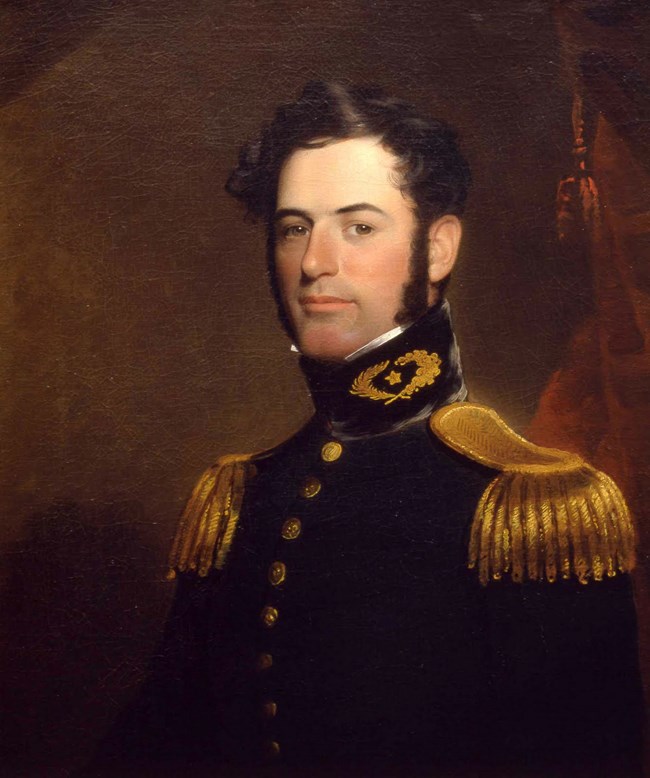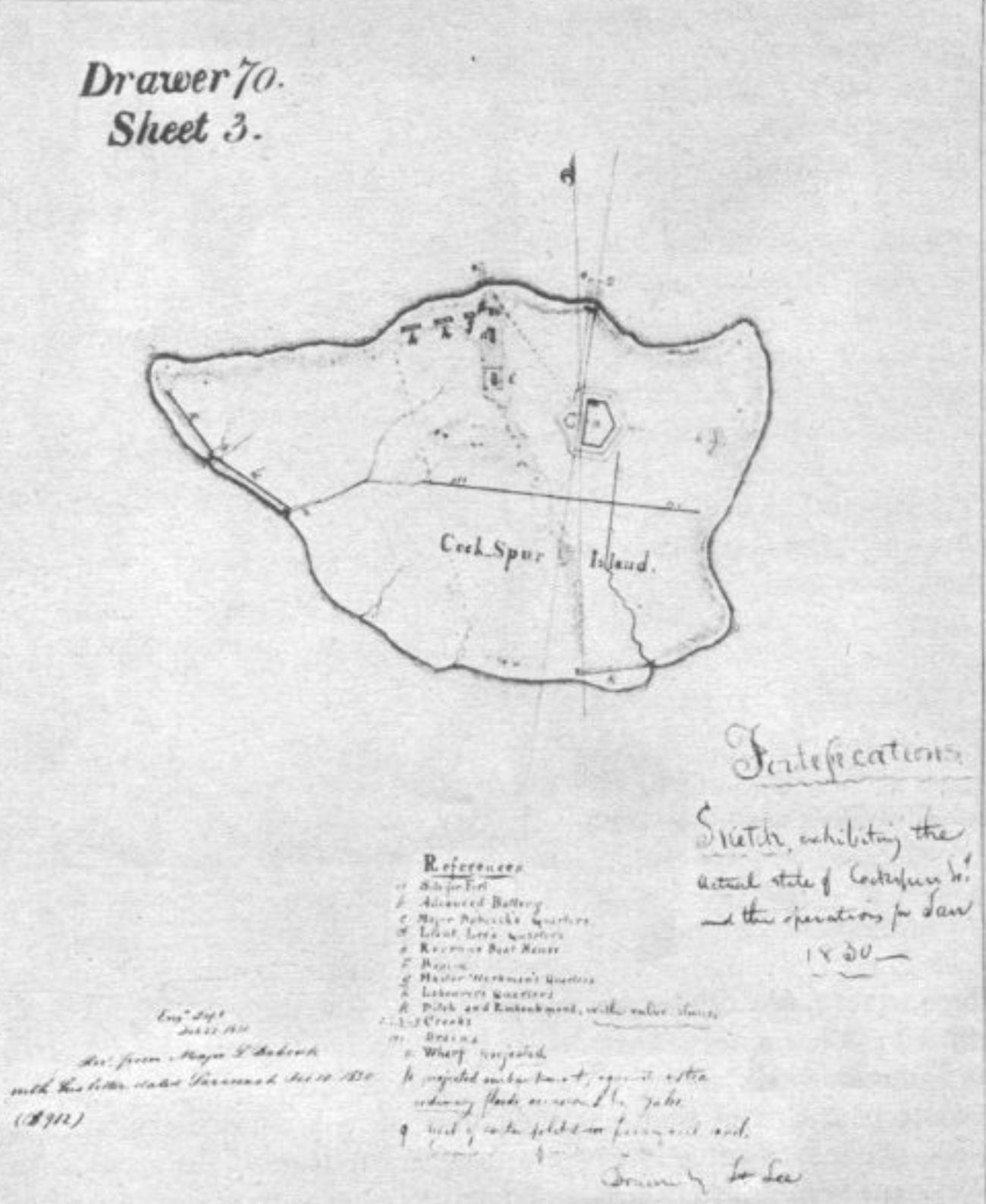Last updated: July 29, 2025
Article
Robert E. Lee and Fort Pulaski

After graduating from West Point, Brevet Second Lt. Robert E. Lee awaited his Army assignment in mid-summer 1829. On August 11, he received his orders from Brigadier General Charles Gratiot, Chief of Engineers. He was to report to Major Samuel Babcock at Cockspur Island, by mid-November.
The assignment to Cockspur Island was likely unappealing to Lieutenant Lee. Construction of a fort on this marshy and isolated island had just begun. Major Babcock had only begun his preliminary surveys the previous December. The project was suspended in June 1829 for the hot months. Lee departed for Savannah in October.
Traveling by coastal steamer, Lee reached Savannah in early November. Major Babcock had not yet returned from the summer hiatus. The suspended project was currently in the hands of an overseer. Work would not resume at the site until Major Babcock returned.
Major Babcock arrived in Savannah on December 23, 1829. He was an older officer in the Engineer Corps with about 20 years of service. His health was poor, so Lee was expected to take on much of the responsibility of fort's construction.
In January 1830, Lieutenant Lee, acting as assistant engineer, took charge of the work on Cockspur Island. He rushed the construction of quarters for workers and officers. He also started drainage systems and began work on the main wharf.
By the end of the month, Lee prepared a map, which he titled, "Sketch exhibiting the actual state of Cockspur Island and the operations for Jan. 1830." The map not only showed the work accomplished, but also the work projected as well. The shore of the island was outlined, and marshy and high ground indicated. The partially finished quarters, the beacon, and the revenue boathouse were shown. The proposed sites of the fort and advanced battery were also indicated. Also included were the planned wharf and system of drainage ditches and embankments.

Lee had ample opportunity for gaining practical engineering experience despite the conditions. Cockspur Island is not an easy area for engineering operations. The island is essentially a mud and marsh island, containing a few low sand ridges. To complete his work, Lee trampled with persistence through the mud and marsh of Cockspur. He spent days surveying the island and its contours.
Major Babcock had realized Lee's ability within a month. While he thought Lee was inexperienced, he also found the young officer "active and intelligent." Babcock had delegated to Lee one of the most important, difficult, and thankless of post tasks, acting assistant commissary.
In February and March, Lee managed his engineering duties on the island's drainage and embankment system while also assuming his new responsibilities. His limited leisure time was spent on trips to Savannah and personal correspondence. However, such diversions became less frequent as early spring progressed. As Major Babcock's health worsened, Lee's responsibilities increased.
By early May, the temporary quarters on Cockspur were usable. A headquarters was established on the island. Lieutenant Lee revised his sketches at the end of February, March, and April 1830. Progress on the buildings, dikes, and drainage ditches was depicted. His sketches showcased the completed officers' and workers' quarters, the first main wharf on the north channel, and the initiation of excavation at the proposed fort site.

Operations on Cockspur were halted in early summer 1830, despite Major Babcock's earlier intention to continue. By July, local physicians advised him to leave the island due to the brutal summer heat and disease-carrying mosquitoes. Babcock never returned, while Lee would return in November.
A bewildering condition on Cockspur confronted the Lee. When he had left the previous July, the system of embankments designed to keep tidal waters off the proposed site were almost finished. The drainage ditches had been completely opened. But a recent storm had been destructive to the improvements on the island. Lee had to act fast to save the project.
The work of the survey and soil examination was producing results. The current soil composition would not support the fort's foundation as it was originally designed. Captain Delafield, of the Engineer Corps, will be reporting to the site to help. He was somewhat experienced with problems like those on Cockspur.
Lieutenant Lee completed his survey in early March 1831. He created a sketch called "Map of Cockspur Island, and position of Fort Pulaski." This map included a detailed survey of the island. It showed the high-water line, fixed terrain features, the current positions of dikes, sluices, and embankments. He also illustrated all temporary buildings, quarters, boat houses, and shops, and marked the proposed site of the fort. After finishing the survey, Lee oversaw the new excavations for the fort's foundations. As March 1831 drew to an end, the Engineer Department decided it was not necessity for two Engineer officers to remain during the summer. Lee was directed leave for Hampton Roads, Virginia, that spring.
Meanwhile, Captain Delafield had arrived to help redesign the foundation plans for the fort. Lee's transfer from Cockspur Island happened shortly after. He received orders on April 21, 1831, to go to Old Point Comfort, Virginia, and report to Captain Talcott for duty.
Lee's first tour of duty in the army ended. He left Cockspur Island, more experienced, more mature, and better equipped for his duties. Lee had profited by the practical problems he had encountered there. The days of his apprenticeship were over.
Lee's Farewell to Fort Pulaski
Thirty full years passed before Lee returned to the marshy soil of Cockspur Island. Major construction work at Fort Pulaski had been finished for 14 years. The red and gray brick structure sat on the foundations he had surveyed. The excavations he had started were finished. The now 54-year-old officer came to make a brief inspection of the fort.
The circumstances of Lee's second and final trip to Cockspur Island in November 1861 were much different from his first visit as a young officer. The long-feared break between the North and South had finally occurred. Following the secession of South Carolina in December 1860, Georgia had dispatched a detachment of the State militia to seize Fort Pulaski on January 3, 1861.
Upon Georgia's secession later in that month, the militia garrisoned at Fort Pulaski was mustered into the Confederate service. Measures were hurriedly taken to strengthen the armament of the fort. Bombardment from the United States Navy was thought to be imminent. On November 7 the US Navy suddenly struck the South Carolina coast at Port Royal Sound, not far from Fort Pulaski. A day later Gen. Robert E. Lee, Confederate States Army, assumed command of the defense of the southeastern coast. Within three days, he was at Fort Pulaski. His urgent and unexpected visit was to give personal instructions regarding the strengthening of the defenses of a fort.
General Lee was personally selected by Jefferson Davis as the best officer to lead the vulnerable southeastern coast. On November 5, the "coasts of South Carolina, Georgia, and East Florida" were "constituted a military department."
In November 1861, Lee was accompanied by Brigadier Geneneral Alexander R. Lawton, commanding the Confederate forces at Savannah, and his staff. They were transported by the tiny paddle-wheel river steamer Ida, on the hasty 25-mile round trip over the mud red waters of the broad Savannah. Landing at the North Pier on Cockspur Island, the party walked the short distance to Fort Pulaski. Here they were welcomed by 25-year-old Major Charles H. Olmstead. He was the commander the detachments of the First Volunteer Georgia Infantry then garrisoned at the fort. The formalities of receiving such distinguished visitors were soon concluded. Olmstead conducted General Lee and his party on a careful tour of the fort and the island.
Major Olmstead became colonel of his regiment in December 1861. He was in command of the Confederate garrison at Fort Pulaski when it was bombarded on April 10-11. He surrendered to United States forces after 30 hours of bombardment. Many years afterwards he wrote an interesting account of the last visit of General Lee to Cockspur Island on that early November day in 1861. Colonel Olmstead recalled that
Prior to the closing of the [Savannah] river [about November 24, when Confederate log obstructions were completed to prevent the passage of Federal gunboats], General Robt. E. Lee, who was then in command of the Military District of South Carolina, Georgia and Florida, visited the Fort and gave instructions for further defensive work to be done—traverses to be built on the ramparts between the guns, ditches dug in the parade to catch shells, the light colonnade in front of the officers quarters to be torn down, blindages of heavy timber to be erected before the casemate doors around the inner circuit of the Fort, and these to be covered by several feet of earth.
It is interesting to quote a remark of Gen'l Lee's at this time. Pointing to the nearest part of Tybee Island, 1700 yards away, he said, "Colonel, they will make it very warm for you with shells from that point but they cannot breach at that distance." From 800 to 900 yards was then laid down in the books as the extreme range at which a wall of good masonry could be attacked with any prospect of success, but up to the Siege of Pulaski, so far as the writer [Olmstead] knows, no fortification had ever been subjected to the fire of rifled guns. Their power against masonry was yet an unknown quantity . . . [Of especial interest is the fact that from the exact point on Tybee Island referred to by Lee in 1861, Federal batteries of rifled cannon successfully breached the walls of Fort Pulaski in 1862].
Immediately after General Lee's return to the city [Savannah] steps were taken in supply the timber required for the work he laid out. Rafts were brought down the South Channel [of the Savannah River] and from thence by a small canal on the South-side of the island into the moat. The whole garrison was put to work and to such good purpose, with such hearty good will, that everything contemplated was practically completed when the bombardment actually began [on April 10, 1862].

A short time afterward, Lee gave instructions for Colonel Olmstead regarding the preparation of the fort for a siege. Then Lee and his party embarked for the return trip to Savannah. Although he was in the area for three more months, General Lee was too occupied to visit Fort Pulaski again.
In the midst of supervising the hurried defense measures along the coast, Lee did not overlook the work under way to strengthen Fort Pulaski. On November 24, US forces occupied Tybee Island, opposite the fort. Five days later, General Lee informed Secretary Benjamin the preparation of Fort Pulaski has progressed slowly. However, he did not think that the US Navy could breach the Savannah River.
Lee took another tour of the coast between Charleston and Fernandina early in January 1862. From his observation of US fleet movements in the area, Lee believed that an attack near Savannah was imminent.
Lee transferred his headquarters from Coosawhatchie to Savannah early in February. It was now necessary for him to closely supervise the defense measures under way at Savannah and Fort Pulaski. By the mid-February, US forces established batteries on the Savannah River, a short distance above Fort Pulaski. Communications between Savannah and Cockspur Island were cut by both river and telegraph.
Under the circumstances, there was little that Lee could do further to assist Colonel Olmstead in the defense of Fort Pulaski. However, on February 17, by a messenger through the marshes, Lee sent these final instructions for the protection of the fort:
Colonel: From the position the enemy has taken in the Savannah River, it becomes necessary that you look to your defense in that direction. I therefore recommend that, if necessary for that purpose, you shift some of your barbette guns [those on top of the fort] to the gorge [rear wall] of the work, and the casemates [bombproof rooms] in the northwest angle, which bear up the river, be provided with guns. I would also recommend that the parapets of the mortar batteries be carried all around, so that the mortars can be protected from the fire up the river as well as from Tybee Island, and that everything be done to strengthen the defenses of your work in the rear.
As far as it is possible your safety will be anxiously cared for, and for the present your communication with the city [Savannah] will have to be by light boats over the marsh . . . or by any other mode by which you can better accomplish it.
In late February, General Lee's difficult assignment on the southeastern neared its end. There were many signs that the slow-moving US naval and land operations in the Savannah area were finally organized for an actual attack. The Confederate situation between Savannah and the coast was dire. By February 23 Lee had begun to believe that Fort Pulaski "may in time be reduced." He continued his efforts to complete the defensive system of earth batteries and waterway obstructions in front of Savannah. On March 2, President Davis suddenly called him to Richmond . A few days after leaving Savannah on March 3, General Lee was assigned to the command of the operations of all Confederate armies. His task of preparing defenses for the southeastern coast was over.
Defense measures undertaken at Fort Pulaski by his direction did not prevent Fort Pulaski's surrender to US forces on April 11. This was accomplished through unforeseen military developments beyond Lee's control. Yet the main defense system between Savannah and the sea, started by Lee, proved to be effective. US forces would not enter the city of Savannah until Sherman arrived late in 1864. Lee would be a part of many important battles fought during the war, finally surrendering to US General U.S. Grant at Appomattox in April 1865.
Based on:
Rogers W. Young, Robert E. Lee and Fort Pulaski, National Park Service Popular Study Series, 1941.
